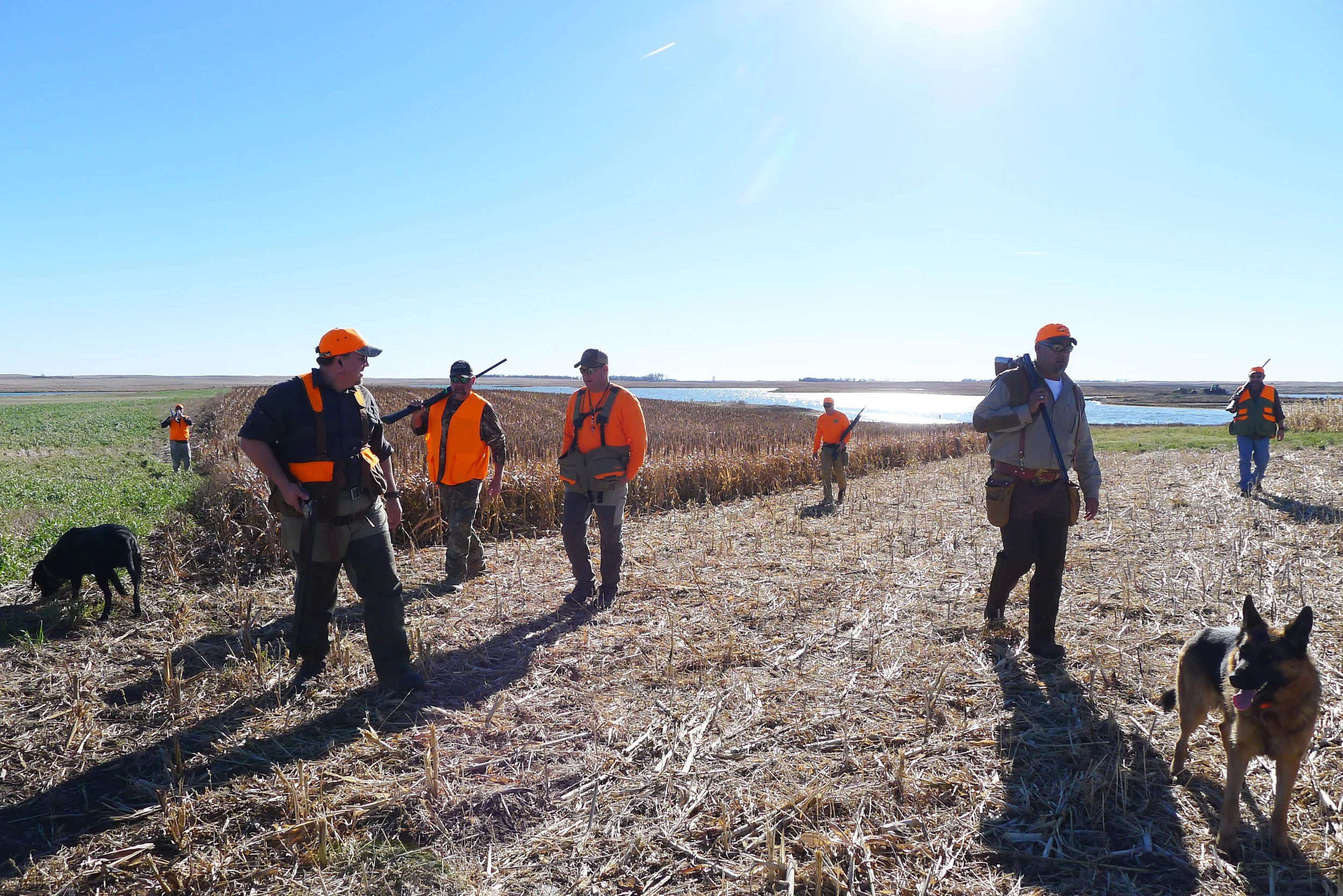Bone weary, bouncing down the dusty red road, paralleling the Matlabas River, the frigid evening air blasted us while sitting in our “popsicle seat.” We were truly freezing our butts off with in the end of another cold, July winter day in South Africa. I was booked, beat, and done in… it was over for the day, everything ached or hurt. I was levering the drop block of my Sharps, ejecting the shell.
My dazed exhaustion was shattered by the cry, “Damn Big Nyala!” booming from the front cab. Looking up, my eyes tearing in the cold cutting wind. A huge buck – there – silhouetted against the dying sun reflecting off the river. Jumping down trying to move to get the shot, I snapped my long-barreled Sharps buffalo gun up, free-handing it just as the bull leapt forward. As I pulled the trigger that evil little voice hiding in every hunter’s head whispered, “What the hell have you done?!” The nyala staggered, stumbled, losing its’ balance.
Smug, I thought, “Hah! It’s going down.” It ought to with 400-grains of Barnes best slamming through a .458 diameter hole now perforating parts unknown. It had knocked down far bigger, meaner, and tougher. Unfortunately my nyala hadn’t read the same ballistics book; he caught himself, got his hooves under him, and then fled the field heading towards heavy brush. My PH, Marius Moolman, shouted, “Hit hard! Find it quick.” Now the recriminations, “Oh David. What have you done? What have you done?”
Leann, my huntress mate, and our second PH, Robie, piled out of the truck. Myself? I felt like banging my head against the truck. A nyala – the most expensive species on the concession, most definitely was not in our budget - try saving money when the whole family of avid hunters goes to Africa! Oh believe me, as an accountant, I knew I was already way over.
It had already been an exceptional day. Leann had taken a steenbok at a very respectable distance; a 25-inch impala with exceptionally heavy horn mass; and an awesome warthog, which had been surprisingly elusive. My son had, that same day, taken a blue wildebeest and red hartebeest. The cost was racking up.
I casted a worried eye towards the descending dusk, this just couldn’t be good. The leaden murk of the African night began settling in by the time we started the stalk. Finding him seemed unlikely. Even worse, as I replayed the shot, I had miscalculated his leap and wounded him – a raking shot, not instantly fatal. Leann was visibly nervous, as we began tracking, more about losing a wounded animal than out of fear of the darkening bush. My 400-grain Barnes, semi spritzer, soft point expands so it’s like a beer can being crammed through the body, creating massive damage, but not great phenomenal penetration longitudinally.
Luckily, we saw the nyala 50 yards across the soggy field in a deep copse of scrub trees, his head barely silhouetted against the dying light. “Well done, David. His head’s down.”
We moved forward, and Marius warned “Careful, it’s the dead ones that kill you.”
I circled around to the left, just in case he bolted so I could get off another shot. Word of caution, always follow the guide so you don’t get people in crossfire - my second mistake of the evening. Marius led with his .30-06, Leann followed, Robie behind.
“There he is!” Marius shouted. We fired an insurance shot and began to close. Marius and Leann moved up quickly; I paralleled outside the bushes, relaxed, gun down. Things were ending up okay after all.
Its’ head was down, horns in the dirt. Dead as a nail – completely and totally lifeless – still as death; and all the other metaphors one wants to pile on. When Marius and Leann got within three feet – maybe less – the bull exploded to life, surging up, his needle-sharp horns down in a dead out eviscerating charge.
It was happening so fast that Marius couldn’t even get his gun to his shoulder. Leann, on the other hand – always fearless to the point of recklessness – stood her ground side-by-side with the PH. From my side view, I immediately saw the danger – someone was fixing to get gutted. I watched helpless as life suddenly slowed down, frame by frame, one at a time as I watched Leann braving the charge with just a flashlight in her hand. Then Robie’s massive hand slowly reaching for her, grabbing her shoulder…then Leann in the air, slowly drifting backwards…Robie thrusting his arms out to each side, throwing his body between Leann and the nyala…forcing her back…Leann not turning to run. Then Marius fired from the hip, John Wayne style.
The nyala, the bullet grazing its ear then penetrating its shoulder, turned and leaped back at the last microsecond, twisting away, and charged through the thicket towards the river road.
In a blink of an eye, it was over: A charge, a shot, and the nyala disappeared. Lost.
Then it hit me: my wife had almost died. Not a campfire story, but real life. She, our guides and friends had almost been killed. That is Africa - where a simple plains game hunt can turn deadly in a heartbeat. Just inches off and someone could have gone down with horrible injuries. I mean the kind of wounds, when your three hours away from a hospital, you die from – painfully. This is the real Africa, with death always a split-second away.
Although I have faced death before, it was my wife’s almost dying from my bad shot that hit me hard: The acid-sick feeling from adrenalin surge, the metallic coppery taste in your mouth, the rifle slipping in your sweating palms, the little wobble in the knees.
Taking a breath, we were off again through a deep velvet night and brilliant stars, but more carefully this time - near death experiences have a way of doing that. Tramping through the grass looking for my “dead” nyala, I thought of Marius, Hemingway’s ideal of “Grace under pressure.”
Trudging through the waist-high grass and brambles, I realized the nyala was lost. Additional trackers were called in, but they feared the roaming leopard. A deadly puff adder had been killed only hours earlier. By the river, no blood signs. We searched the road while Marius continued alone along the river.
After long hours of searching Marius called out. He’d found the dead buck at the river’s edge, partially in the water. The trackers pulled him from the river. My trophy saved, I helped, and we drug him 80 yards to the road. It was just too much to be left to the trackers. Everyone helped out by rotating. It was exhausting.
A last-minute, poorly placed shot had almost cost much more than a lost trophy. The time it takes for something to go terribly wrong in Africa - a heart beat.
Today, my nyala represents not only its fine 29-inch horns, but also the lessons learned that fateful night. Courage can be quiet and calm, not the gin hazed campfire bravado, but the real kind that defines a hunter. Seeing that animal from the far side of death burst back to life will always make me recall how time can run like slow molasses, it trickles along a frame at a time. Life and death balanced by the most tenuous thread, and you watch, a helpless voyeur, both drawn and repelled by the drama that is Africa. Manzi Reserve, South Africa
The spectacular 13,000-acre Manzi River reserve is approximately 30 miles west of Thabazimbi in the Limpopo province. Now strictly a bow hunters paradise – no guns! Its terrain varies from riverine forest to flats to heavy bush, and even to a lake with marshlands. The hunting reserve is located on one of the few rivers in the arid Limpopo, the Matblas. The luxurious lodge overlooks a waterfall; and there are spectacular evening boat rides. All animals taken in this two-week hunt made Exotic Wildlife Association top five for the year – most number one in their class. www.africabowhunt.com
Owners Danie and Janine Van Jaarsveld, and PHs Marius Moolman and Robie Mentz, all do a good job. On a very reasonable budget, this was one of the greatest experiences in our lives.
The Dream Gun:
I was able to combine my dream hunt with my dream rifle: the legendary hunting firearm from the American Old West, a Sharps Buffalo gun. I used an 1874 C. Sharps Buffalo Rifle, in the antiquated 45-90 caliber, with a tapered octagon 34-inch barrel and a Creedmore Vernier mid-range sight, including on a steenbok at 120 meters with just the neck and head showing above the bushes.






























































